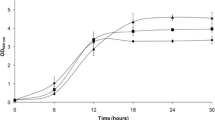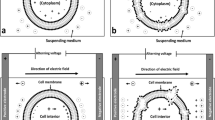Abstract
Cell physiology parameters are essential aspects of biological processes; however, they are difficult to determine on-line. Dielectric spectroscopy allows the on-line estimation of viable cells and can provide important information about cell physiology during culture. In this study, we investigated the dielectric property variations in Kluyveromyces marxianus SLP1 and Saccharomyces cerevisiae ERD yeasts stressed by 5-hydroxymethyl-2-furaldehyde and 2-furaldehyde during aerobic growth. The dielectric properties of cell permittivity, specific membrane capacitance (Cm), and intracellular conductivity (σIn) were considerably affected by furan aldehydes in the same way that the cell population, viability, cell size, substrate consumption, organic acid production, and respiratory parameters were. The yeasts stressed with furan aldehydes exhibited three physiological states (φ): adaptation, replicating, and nonreplicating states. During the adaptation state, there were small and stable signs of permittivity, Cm, and σIn; additionally, no cell growth was observed. During the replicating state, cell growth was restored, and the cell viability increased; in addition, the permittivity and σIn increased rapidly and reached their maximum values, while the Cm decreased. In the nonreplicating state, the permittivity and σIn were stable, and Cm decreased to its minimum value. Our results demonstrated that knowing dielectric properties allowed us to obtain information about the physiological state of the cells under control and stressed conditions. Since the permittivity, Cm, and σIn are directly associated with the physiological state of the yeast, these results should contribute to a better understanding of the stress response of yeasts and open the possibility to on-line monitor and control the physiological state of the cell in the near future.




Similar content being viewed by others
References
Allen SA, Clark W, McCaffery JM, Cai Z, Lanctot A, Slininger PJ, Liu ZL, Gorsich SW (2010) Furfural induces reactive oxygen species accumulation and cellular damage in Saccharomyces cerevisiae. Biotechnol Biofuels 3:2
Ansorge S, Esteban G, Schmid G (2007) On-line monitoring of infected Sf-9 insect cell cultures by scanning permittivity measurements and comparison with off-line biovolume measurements. Cytotechnology 55:115–124. https://doi.org/10.1007/s10616-007-9093-0
Ansorge S, Esteban G, Schmid G (2010) Multifrequency permittivity measurements enable on-line monitoring of changes in intracellular conductivity due to nutrient limitations during batch cultivations of CHO cells. Biotechnol Prog 26:272–283. https://doi.org/10.1002/btpr.347
Belo I, Pinheiro R, Mota M (2005) Morphological and physiological changes in Saccharomyces cerevisiae by oxidative stress from hyperbaric air. J Biotechnol 115:397–404. https://doi.org/10.1016/j.jbiotec.2004.09.010
Carvell JP, Dowd JE (2006) On-line measurements and control of viable cell density in cell culture manufacturing processes using radio-frequency impedance. Cytotechnology 50:35–48
Dopp E, Jonas L, Nebe B, Budde A, Knippel E (2000) Dielectric changes in membrane properties and cell interiors of human mesothelial cells in vitro after crocidolite asbestos exposure. Environ Health Perspect 108:153–158
Farías-Álvarez LJ, Gschaedler-Mathis A, Sánchez-Ortiz AF, Femat R, Cervantes-Martínez J, Arellano-Plaza M, Zamora-Pedraza C, Amillastre E, Ghommidh C, Herrera-López EJ (2018) Xanthophyllomyces dendrorhous physiological stages determination using combined measurements from dielectric and Raman spectroscopies, a cell counter system and fluorescence flow cytometry. Biochem Eng J 136:1–8. https://doi.org/10.1016/j.bej.2018.04.016
Ferris LE, Davey CL, Kell DB (1990) Evidence from its temperature dependence that the β-dielectric dispersion of cell suspensions is not due solely to the charging of a static membrane capacitance. Eur Biophys J 18:267–276. https://doi.org/10.1007/BF00188039
Flores-Cosío G, Arellano-Plaza M, Gschaedler-Mathis A, Amaya-Delgado L (2018) Physiological response to furan derivatives stress by Kluyveromyces marxianus SLP1 in ethanol production. Rev Mex Ing Quim 17:189–202
Gibson BR, Lawrence SJ, Leclaire JPR, Powell CD, Smart KA (2007) Yeast responses to stresses associated with industrial brewery handling. FEMS Microbiol Rev 31:535–569. https://doi.org/10.1111/j.1574-6976.2007.00076.x
Gupta A, Verma JP (2015) Sustainable bio-ethanol production from agro-residues: a review. Renew Sust Energ Rev 41:550–567. https://doi.org/10.1016/j.rser.2014.08.032
Kiehl TR, Shen D, Khattak SF, Jian Li Z, Sharfstein ST (2011) Observations of cell size dynamics under osmotic stress. Cytometryt A 79:560–569. https://doi.org/10.1002/cyto.a.21076
Labeed FH, Coley HM, Hughes MP (2006) Differences in the biophysical properties of membrane and cytoplasm of apoptotic cells revealed using dielectrophoresis. Biochim Biophys Acta 1760:922–929. https://doi.org/10.1016/j.bbagen.2006.01.018
Liu ZL (2011) Molecular mechanisms of yeast tolerance and in situ detoxification of lignocellulose hydrolysates. Appl Microbiol Biotechnol 90:809–825. https://doi.org/10.1007/s00253-011-3167-9
Liu ZL, Slininger PJ, Dien BS, Berhow MA, Kurtzman CP, Gorsich SW (2004) Adaptive response of yeasts to furfural and 5-hydroxymethylfurfural and new chemical evidence for HMF conversion to 2,5-bis-hydroxymethylfuran. J Ind Microbiol Biotechnol 31:345–352. https://doi.org/10.1007/s10295-004-0148-3
Liu ZL, Moon J, Andersh BJ, Slininger PJ, Weber S (2008) Multiple gene-mediated NAD(P)H-dependent aldehyde reduction is a mechanism of in situ detoxification of furfural and 5-hydroxymethylfurfural by Saccharomyces cerevisiae. Appl Microbiol Biotechnol 81:743–753. https://doi.org/10.1007/s00253-008-1702-0
Ma M, Liu ZL (2010) Comparative transcriptome profiling analyses during the lag phase uncover YAP1, PDR1, PDR3, RPN4, and HSF1 as key regulatory genes in genomic adaptation to the lignocellulose derived inhibitor HMF for Saccharomyces cerevisiae. BMC Genomics 11:660. https://doi.org/10.1186/1471-2164-11-660
Ma M, Han P, Zhang R, Li H (2013) Ultrastructural changes of Saccharomyces cerevisiae in response to ethanol stress. Can J Microbiol 59:589–597. https://doi.org/10.1139/cjm-2012-0745
Matyash V, Liebisch G, Kurzchalia TV, Shevchenko A, Schwudke D (2008) Lipid extraction by methyl-tert-butyl ether for high-throughput lipidomics. J Lipid Res 49:1137–1146. https://doi.org/10.1194/jlr.D700041-JLR200
Opel CF, Li J, Amanullah A (2010) Quantitative modeling of viable cell density, cell size, intracellular conductivity, and membrane capacitance in batch and fed-batch CHO processes using dielectric spectroscopy. Biotechnol Prog 26:1187–1199. https://doi.org/10.1002/btpr.425
Patel P, Markx GH (2008) Dielectric measurement of cell death. Enzyme Microb Tech 43:463–470. https://doi.org/10.1016/j.enzmictec.2008.09.005
Patel PM, Bhat A, Markx GH (2008) A comparative study of cell death using electrical capacitance measurements and dielectrophoresis. Enzyme Microb Tech 43:523–530. https://doi.org/10.1016/j.enzmictec.2008.09.006
Pethig R, Talary M (2007) Dielectrophoretic detection of membrane morphology changes in Jurkat T-cells undergoing etoposide-induced apoptosis. IET Nanobiotechnol 1:2–9
Sandoval-Nuñez D, Arellano-Plaza M, Gschaedler A, Arrizon J, Amaya-Delgado L (2017) A comparative study of lignocellulosic ethanol productivities by Kluyveromyces marxianus and Saccharomyces cerevisiae. Clean Technol Envir Policy 20:1–9. https://doi.org/10.1007/s10098-017-1470-6
Sehnem NT, da Silva MA, Leite FCB, de Barros PW, de Morais MA, Ayub MAZ (2013) 5-Hydroxymethylfurfural induces ADH7 and ARI1 expression in tolerant industrial Saccharomyces cerevisiae strain P6H9 during bioethanol production. Bioresour Technol 133:190–196. https://doi.org/10.1016/j.biortech.2013.01.063
Siegel DP, Epand RM (1997) The mechanism of lamellar-to-inverted hexagonal phase transitions in phosphatidylethanolamine: implications for membrane fusion mechanisms. Biophys J 73:3089–3111. https://doi.org/10.1016/S0006-3495(97)78336-X
Tibayrenc P, Preziosi-Belloy L, Roger JM, Ghommidh C (2010) Assessing yeast viability from cell size measurements? J Biotechnol 149:74–80. https://doi.org/10.1016/j.jbiotec.2010.06.019
Tibayrenc P, Preziosi-Belloy L, Ghommidh C (2011) On-line monitoring of dielectrical properties of yeast cells during a stress-model alcoholic fermentation. Process Biochem 46:193–201. https://doi.org/10.1016/j.procbio.2010.08.007
Van Der Rest ME, Kamminga AH, Nakano A, Anraku Y, Poolman B, Konings WN (1995) The plasma membrane of Saccharomyces cerevisiae: structure, function, and biogenesis. Microbiol Rev 59:304–322
Wang X, Becker FF, Gascoyne PR (2012) Membrane dielectric changes indicate induced apoptosis in HL-60 cells more sensitively than surface phosphatidylserine expression or DNA fragmentation. Biochim Biophys Acta 1564:412–420. https://doi.org/10.1158/0008-5472.CAN-10-4002.BONE
Xia JM, Yuan YJ (2009) Comparative lipidomics of four strains of Saccharomyces cerevisiae reveals different responses to furfural, phenol, and acetic acid. J Agric Food Chem 57:99–108. https://doi.org/10.1021/jf802720t
Zimmermann D, Zhou A, Kiesel M, Feldbauer K, Terpitz U, Haase W, Schneider-Hohendorf T, Bamberg E, Sukhorukov VL (2008) Effects on capacitance by overexpression of membrane proteins. Biochem Biophys Res Commun 369:1022–1026. https://doi.org/10.1016/j.bbrc.2008.02.153
Funding
This study was funded by the “Fondo de Sustentabilidad Energética” Projects 245750 and 249564 CONACYT-SENER. Flores-Cosío Guillermo received a grant from CONACYT, México.
Author information
Authors and Affiliations
Corresponding author
Ethics declarations
Competing interests
The authors declare that they have no competing interests.
Ethical statement
This article does not contain any studies with human participants or animals performed by any of the authors.
Additional information
Publisher’s note
Springer Nature remains neutral with regard to jurisdictional claims in published maps and institutional affiliations.
Electronic supplementary material
ESM 1
(PDF 592 kb).
Rights and permissions
About this article
Cite this article
Flores-Cosío, G., Herrera-López, E.J., Arellano-Plaza, M. et al. Dielectric property measurements as a method to determine the physiological state of Kluyveromyces marxianus and Saccharomyces cerevisiae stressed with furan aldehydes. Appl Microbiol Biotechnol 103, 9633–9642 (2019). https://doi.org/10.1007/s00253-019-10152-2
Received:
Revised:
Accepted:
Published:
Issue Date:
DOI: https://doi.org/10.1007/s00253-019-10152-2




